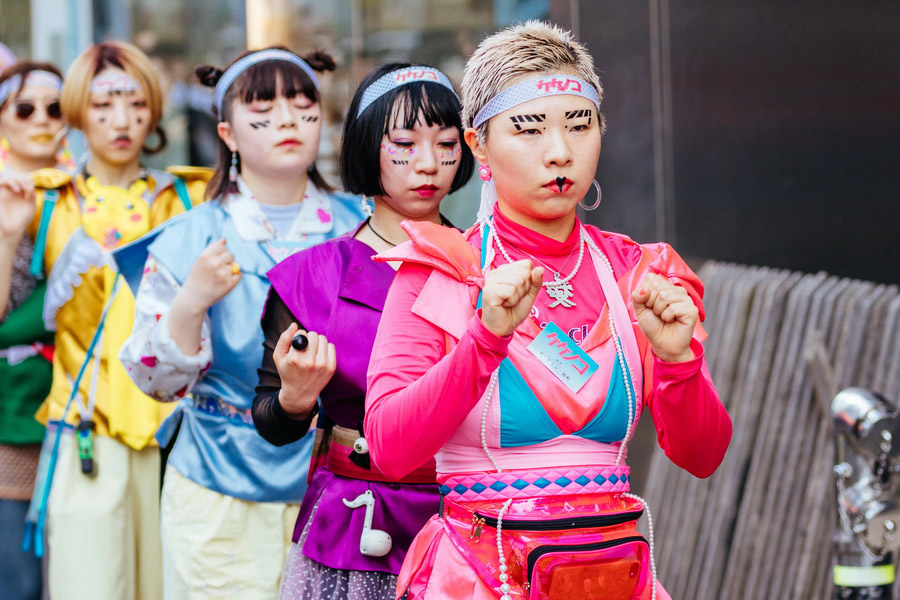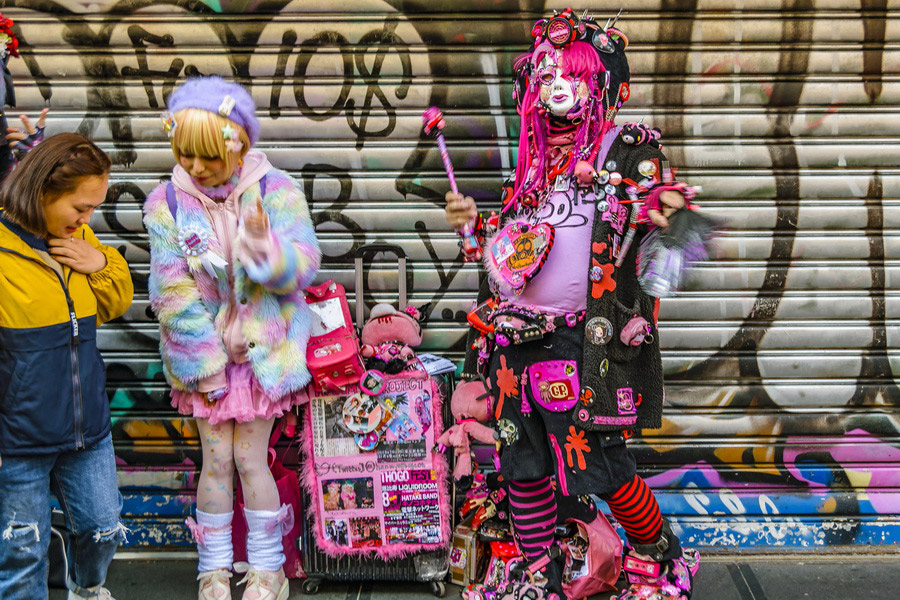Harajuku, Tokyo

Harajuku (原宿) is not just a district in central Tokyo but a cultural hub that combines modern fashion trends, youth culture, and traditional Japanese architecture. This area has become a popular destination for tourists, known for its eclectic style, vibrant streets, and a wide variety of stores selling both modern and vintage clothing, as well as unique souvenirs.
The district is centred around two main streets, Omotesandō and Takeshita, where you can find shops offering styles such as Gothic, Lolita, visual kei (v-kei), hip-hop, and punk.
However, Harajuku isn't just about fashion. It's also home to significant landmarks like the Meiji Shrine and Yoyogi Park (Yoyogi kōen), offering a peaceful contrast to the bustling shopping scene.
Omotesandō Street
Originally established to lead to the Meiji Jingū Shrine, Omotesandō Street has evolved into a prestigious shopping district, with boutiques of renowned international brands and Japanese designers.
Today, Omotesandō is not only a shopping destination but also a symbol of Tokyo's architectural and cultural evolution. Many of the buildings are designed by famous architects, and each shop front looks like a work of art, attracting fashion enthusiasts from around the world.
Omotesandō is particularly famous for its luxury boutiques and flagship stores of global fashion brands, including Louis Vuitton, Prada, Gucci, Dior, Chanel, and more. Alongside these international names, you’ll also find Japanese designer shops featuring clothing, accessories, jewellery, and home décor. Purchasing here is not just a shopping experience but an immersion into the world of haute couture.
Takeshita Street
Takeshita Street is a narrow pedestrian street located in Tokyo's Harajuku district, famously known as the heart of Japanese youth culture and fashion experimentation. This vibrant street has become a symbol of self-expression, attracting fans of various subcultures like Gothic, Lolita, anime, and anyone eager to stand out with bold outfits and accessories. Even celebrities like Lady Gaga are known to come here.
Takeshita Street draws not only tourists but also local Japanese youth who want to express their distinctive style. On weekends, the street comes alive with young people dressed in unique costumes, contributing to the colourful and lively atmosphere.
The boutiques along the street sell a vast selection of clothing and accessories, ranging from vintage pieces to cutting-edge designer items. Popular finds include:
- Japanese street fashion, particularly Gothic and Lolita styles;
- Vintage shops catering to those who appreciate trendy retro looks;
- Boutiques offering distinctive accessories such as handbags, shoes, and costume jewellery;
- Anime and pop culture stores filled with figurines, posters, and other merchandise.
Takeshita Street is a must-visit for anyone interested in Japan's dynamic youth fashion scene.
Harajuku Style

Harajuku style began evolving in the 1980s when Japanese youth started using the Harajuku district to show off their bold and unconventional outfits. After World War II, American shops with unique clothing opened in the area, attracting young people. Over time, independent designers with bold fashion experiments emerged, turning the neighbourhood into a hub of creativity.
By the 1990s, Harajuku became synonymous with street fashion and subcultures, transforming into a global centre for youth culture and innovative fashion. Teenagers and young adults flocked to the area to express their individuality through clothing.
The Japanese magazine FRUiTS, launched in 1997 by photographer Aoki Shōichi, played a significant role in promoting Harajuku street fashion abroad. Aoki captured Harajuku's distinct styles in the magazine, which quickly gained popularity in Japan and overseas. Although the print version ceased in 2017, FRUiTS continues to post publications on Instagram, and it is still managed by Aoki.
Popular Harajuku Style Trends:
- Lolita. Inspired by Victorian fashion, Lolita's outfits include puffy skirts, lace dresses, high socks, hats, and bows. It has subcategories such as Gothic Lolita, Sweet Lolita, and Classic Lolita.
- Gyaru. Known for its “cover girl” look with heavy makeup, artificial eyelashes, curled hair, and brightly coloured clothes, Gyaru was especially popular in the 1990s and early 2000s.
- Kawaii. Meaning "cute" in Japanese, this style emphasises brightness and sweetness, with outfits inspired by anime characters, pastel colours, and cute accessories like cuddly toys and baby hair clips.
- Decora. Known for its eccentric style with an excessive use of accessories, Decora involves wearing bright hairpins, bracelets, and rings. The more accessories, the better.
- Cyberpunk and Futurism. Inspired by science fiction, this trend features transparent materials, glowing elements, and neon colours.
- Bōsōzoku.This style is associated with rebellious motorcycle culture, featuring long jackets with colourful dragons, tigers, or Japanese symbols embroidered.
- Cosplay. A form of art where enthusiasts dress as anime, manga, video game, or movie characters, focusing on costume accuracy through handsewn outfits, wigs, and makeup.
- Goth. Like European Gothic fashion, this style includes black clothing, piercings, and accessories. Many Harajuku styles also have Gothic variations.

Harajuku fashion has long spread outside Japan, influencing the global fashion industry. It inspires designers, fashion brands, and street stylists worldwide to create eclectic collections that emphasise creativity and individuality.
Famous musicians like Gwen Stefani have popularised Harajuku style in the West, and K-pop stars frequently incorporate its elements into their stage outfits. Harajuku street fashion, deeply rooted in Japanese culture, symbolises uninhibited, daring fashion that challenges stereotypes and encourages experimentation with appearance.
Cafes and Restaurants
Harajuku is known not only for its fashion scene but also for its wide range of unique cafes and restaurants that attract both locals and tourists. From traditional Japanese cuisine to quirky themed cafes, there's something for every palate.
Here are a few must-visit places while strolling through Harajuku:
- Crepe Cafes. No visit to Harajuku is complete without stopping by one of its many crepe cafes. Takeshita Street is home to several stalls offering crepes with toppings like fruit, whipped cream, chocolate, and ice cream, making them a perfect street snack and a symbol of Harajuku's street food culture.
- A Happy Pancake Omotesandō. This popular cafe is a paradise for sweet lovers, serving incredible fluffy Japanese pancakes. These airy, soft pancakes melt in your mouth and come with toppings ranging from honey to butter and fruit. It's a favourite spot for tourists, so arriving early is recommended to avoid long queues.
- Ichiran Ramen. For those having a craving for traditional Japanese ramen, Ichiran Ramen offers a classic experience. Known for its rich pork broth and customisable noodles, this restaurant lets you personalise your ramen with ingredients and spice levels, creating a tailored dish every time.
Harajuku’s cafes and restaurants offer a delightful mix of extravagant sweets and authentic Japanese dishes, making it a food lover's paradise. Whether you’re grabbing a quick snack or sitting down for a relaxed meal, Harajuku's food scene is as diverse and creative as its fashion.
How to Get to Harajuku?
The easiest way to reach Harajuku is by Japan's public transportation system. Take the JR Yamanote Line and get off at Harajuku Station, or opt for the Tokyo Metro Chiyoda or Fukutoshin lines, getting off at Meiji-Jingūmae Station. Both are within walking distance of Harajuku's main attractions.
Visiting Tips for Harajuku
- To check store hours in advance
Many stores open from 11:00 AM. to 8:00 PM., so plan your visit accordingly. - To choose a good time to visit
Harajuku is especially lively on weekends when both tourists and locals flock to the area. If you're interested in seeing the vibrant street fashion and experiencing the true spirit of the neighbourhood, it's best to visit on a Saturday or Sunday. However, if you prefer a quieter atmosphere without the crowds, a weekday visit is ideal. - To take pictures respectfully
Harajuku is one of the most photogenic spots in Tokyo. The colourful streets, unique shop fronts, and eclectic outfits provide excellent photo opportunities. Nevertheless, it is wise to bear in mind that not all locals like to be photographed, so it is advised to always seek permission before photographing passers-by. - To respect the street culture
Harajuku is the epicentre of a distinct youth culture, where fashion is a key form of self-expression. While exploring the area, seen as a safe place to express oneself, visitors are expected to appreciate the diversity of styles without making judgements based on the appearance. Harajuku thrives on individuality, offering everyone a space for creative freedom.
Harajuku is a unique district in Tokyo, embodying creativity, freedom of expression, and cultural diversity. For tourists, it's a chance to dive into the world of unconventional fashion, taste unique dishes, and experience Japanese culture from a fresh perspective. Be sure to add Harajuku to your Tokyo itinerary to fully appreciate its vibrancy and creative energy.

